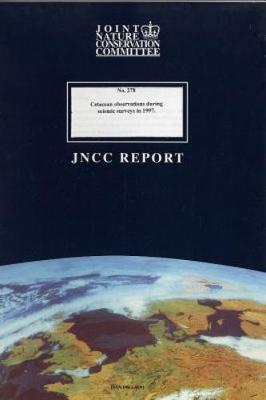JNCC Report
1 primary work
Book 278
This report contains the results of the recording of cetaceans during 1997 operations in UK waters and some adjacent areas, in compliance with the Guidelines for Minimising Acoustic Disturbance to Small Cetaceans. This yielded a total of 730 sightings comprising 8528 individuals. The most frequently seen species were pilot whales, fin whales, sperm whales, white-sided dolphins, common dolphins, white-beaked dolphins and minke whales. Sightings peaked during July and August and were particularly concentrated in deep waters to the north-west of the UK.After taking account of various factors such as geographical distribution, seasonal variations in sightings, weather conditions and the power output of the airguns, the sighting rate of pilot whales was found to be significantly higher while the airguns were firing during seismic surveys, while white-sided dolphins, white-beaked dolphins and all dolphin speciescombined were seen significantly less often during periods of shooting. Sighting rates of finwhales, fin/ sei whales, sperm whales and all large whales combined did not differ significantly between periods of shooting and not shooting.Allowing for weather conditions at the time of sighting, white-sided dolphins, unidentified dolphins, minke whales and fin/ sei whales were found to be significantly further from the airguns when they were firing during seismic surveys than when they were not. Most other species were also further from the airguns during periods of shooting, but not significantly so. Although white-sided dolphins remained further from the airguns during periods of shooting, they were less far away if they were in association with pilot whales than if they were on their own.There were some behavioural responses to seismic activity. Pilot whales and fin whales were more likely to swim at an increased speed during periods of shooting. Cetaceans altered course more often when the airguns were firing than when they were not firing. A significantly greater number of pods of pilot whales were seen to be heading away from the ship when the airguns were firing. Sperm whales dived more often during periods of shooting. Positive interactions of cetaceans with the survey vessel (bow-riding, swimming alongside the paravanes, following the vessel or approaching the vessel) were more frequent when the airguns were not firing, although some individuals were sufficiently tolerant of seismic activity to engage in positive interactions with the vessel while the airguns were firing.There were indications that in deeper water the effects of seismic activity may be reduced. Relatively more cetaceans were seen during periods of shooting in deeper waters than during these periods in shallower waters.Sample sizes from site surveys (small scale localised surveys, usually made prior to drilling) were small, therefore results from these surveys should be treated with particular caution. There were indications from site surveys that sighting rates of dolphins were higher when the airguns were not firing, while sighting rates of pilot whales and unidentified large whales were higher when the airguns were firing. However, sample sizes were too small to test the statistical significance of these results. No significant differences were found in the distance of cetaceans from the airguns between periods of shooting and not shooting.The results presented here confirm many of the findings of previous analyses of data collected during seismic surveys. The only exception is that pilot whales have on some occasions previously been seen less frequently during periods of shooting, whereas in the present study the opposite situation was found.Recommendations are made for minor revisions to the existing recording forms and an additional form is proposed.
